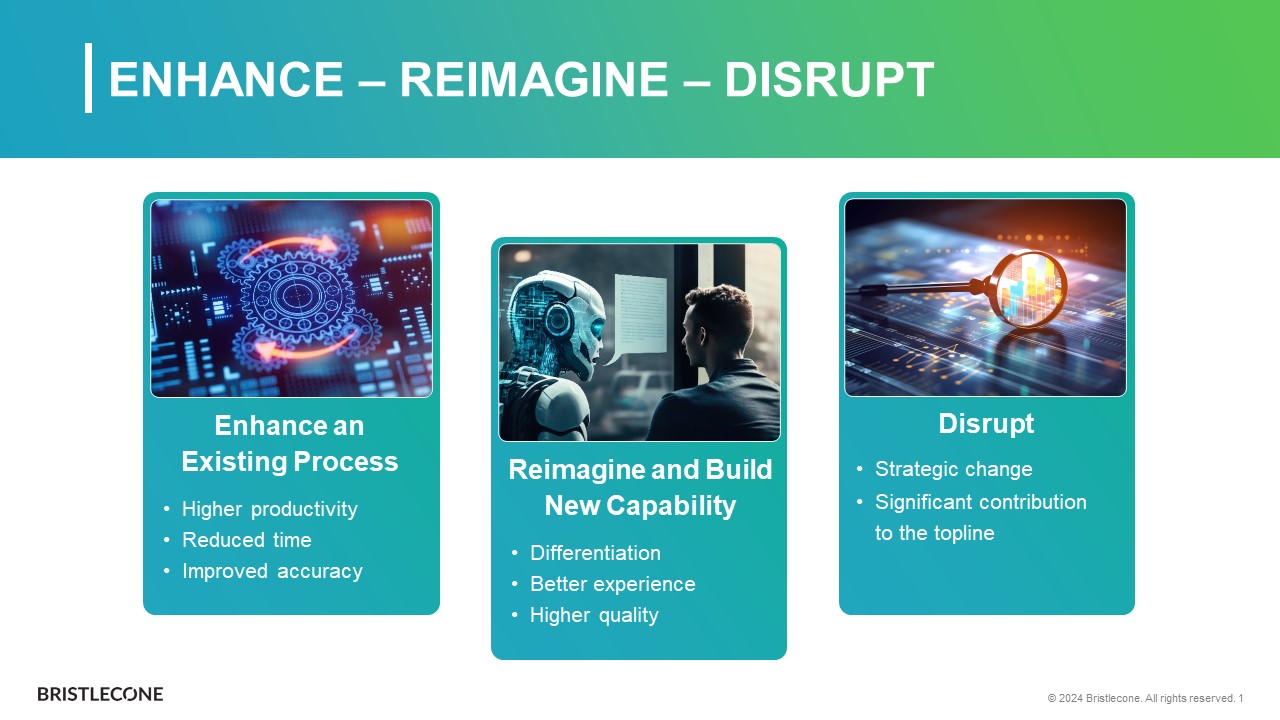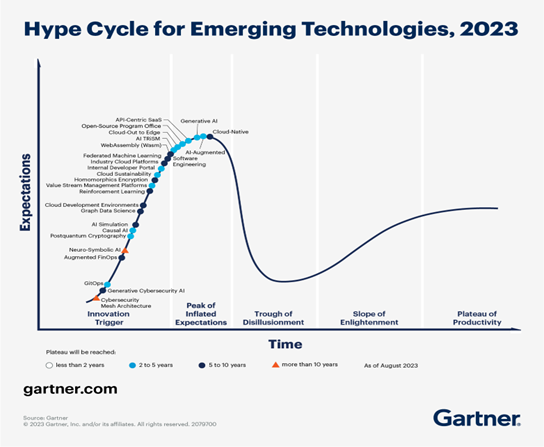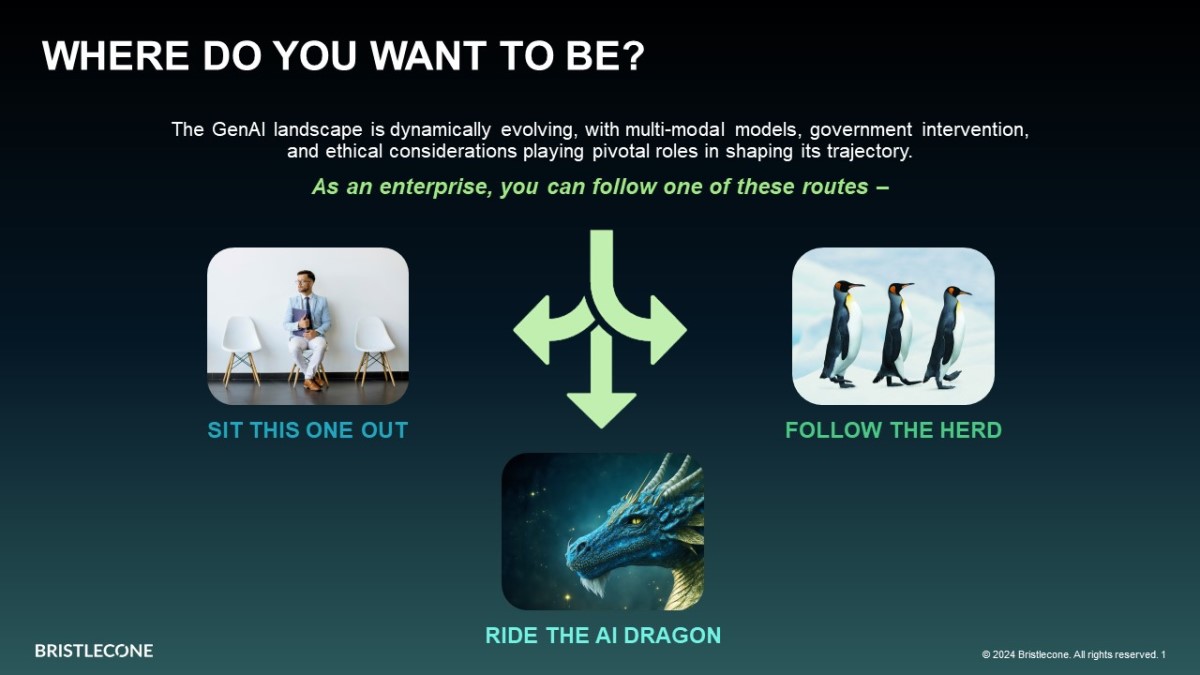
In my last article, I wrote about the three inventive use cases that we had harnessed using the power of the ever-so-popular Generative AI (GenAI). Since November, when that article was published, we commercialized these three use cases – and added a few more to our portfolio.
GenAI use cases, in our view and the view of many research organizations, can be classified in the following ways:
1
Enhance an Existing Process
Use GenAI to improve everyday work productivity. An example would be leveraging GenAI-powered digital assistants to write emails or summarize meetings. BCG believes that this can result in a 10% to 20%, or even more, productivity gain across the enterprise.
2
Reimagine and Build New Capability
Imagine integrating the power of GenAI with your proprietary data or other analytics processes to achieve efficiency and effectiveness gains of 30% to 50%. An integrated GenAI assistant for your shipment data that lets you monitor your shipment locations, corresponding disruptions and suggest alternative actions is a good example.
3
Disrupt
Can GenAI be used to develop a completely new offering, creating long-term differentiation and revenue gains? The idea may seem far-fetched now (although some companies have already embarked on this experimentation journey), but at the pace at which this technology is advancing (introduction of multi-modality in Open AI’s GPT-4, Google’s Gemini, and use case-specific open-source LLMs), it’s only a matter of time.
Gartner has placed GenAI at the peak of ‘inflated expectation’ in their Hype Cycle for AI and is expecting it to reach the ‘plateau of productivity’ in two to five years. In my opinion, GenAI has the potential to reach that phase faster than expected, partly due to the recent advancements (like those mentioned above) and the pace at which this technology is being adopted. Every company wants to know more about GenAI, and many are already seeking ways to adopt it.
Another catalyst here could be the efforts being made by the major players to resolve the data privacy concerns. Companies are finding the idea of bringing the power of LLMs to their ecosystem, rather than sending their data to the foundation models, very appealing.
1
Sit This One Out
This is perhaps the easiest thing to do right now. Let the dust settle and jump in when the hype has been proven. Let the technology go mainstream and prove its value with some real-life examples. You’ll reap the productivity and efficiency benefits, but so will everyone else.
2
Follow the Herd
It’s not surprising that all major enterprise platforms like SAP, Oracle, Salesforce, Workday, etc., have already announced their plans to embed GenAI capabilities into their solutions, with digital assistants being the lowest hanging fruit for everyone. SAP’s Joule, Salesforce’s Einstein GPT and Microsoft’s Copilot are already out there for you to try. This is a great starting point for companies and a perfect segue to short-term differentiation.
3
Ride the AI Dragon
Perhaps the most ambitious approach to GenAI. The first movers have never had it easy – the risks, the uncertainty and the fear of uncharted territory. The desire to prove rapid ROI has never been higher; and given the economic situation, it might not seem very prudent either. But ignoring the potential of GenAI (McKinsey estimates that Generative AI could add the equivalent of $2.6 trillion to $4.4 trillion annually to the global economy) is not a mistake that you would want to make. Ask yourself, when was the last time a technology appealed so much to people and industries across almost all verticals? Looking for a long-term partner to help you embark on this journey and cover the technological aspects of embedding GenAI, while you focus on the business case, can be an approach worth considering. You can also take a more ambitious approach and meet this innovation challenge head-on. Some aspects to consider before making this choice include the availability of resources, technology expertise and frameworks to assess use cases.
Bristlecone can help you identify potential GenAI use cases that are specific to your needs, assist you in curating a use case map with supporting business cases, and facilitate rapid prototyping of the shortlisted use cases. You can also leverage our preconfigured GenAI-powered digital assistants for various business functions to achieve quick productivity gains.
'Strategies for Deploying GenAI in the Enterprise'
Missed our recent panel discussion? Watch it now ...
GenAI has disrupted the market and businesses are leaving no stone unturned to find the first personalized use cases. While for some companies, it may be just a small step to increase productivity, others are now recognizing GenAI’s potential as a revenue generator.
Which one is it going to be for you?






